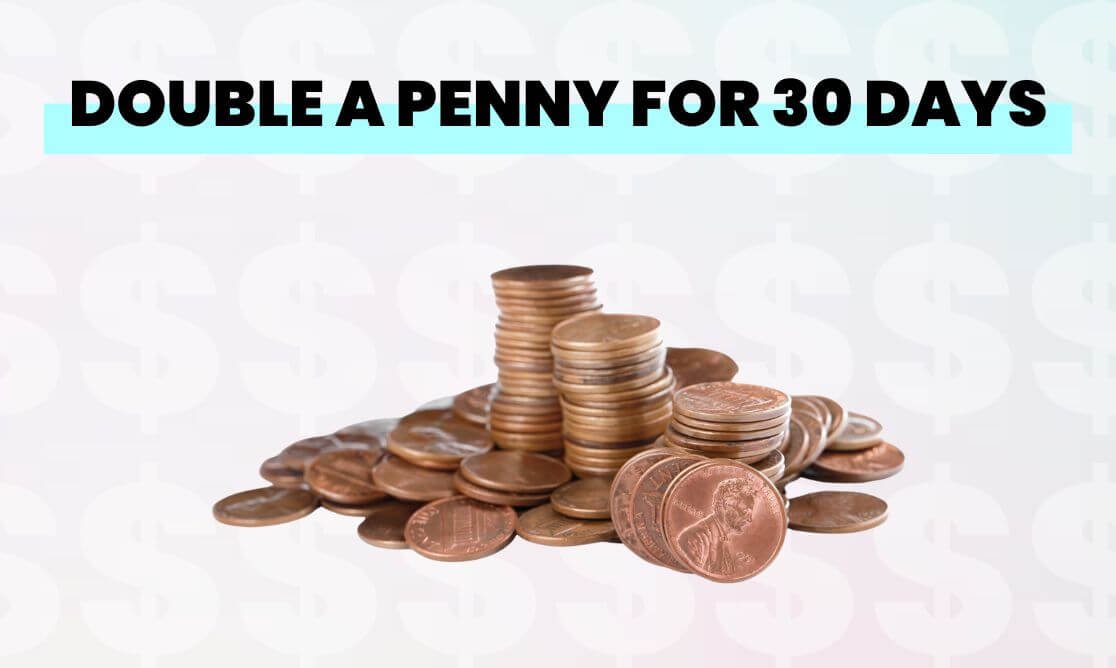Doubling a penny is a widely recognized and timeless financial approach with historical and cultural significance. It traces back centuries and transcends various cultures.
A captivating Indian tale recounts the introduction of chess — and a lesson on exponential growth — to a Raja by its inventor. In return, the inventor asked for a seemingly modest reward: one grain of rice that doubles for each square on the chessboard. The Raja agreed, unaware of the immense consequences. To his astonishment, the inventor swiftly and massively depleted the kingdom's rice supply.
The "double a penny for 30 days" challenge relies on compound interest, where interest is earned on top of previously earned interest. Compound interest is a powerful tool for growing wealth over time, and doubling a penny exemplifies its application, enabling remarkably fast wealth accumulation through exponential growth.

Coming up next
Key takeaways
- The "double a penny for 30 days" showcases the remarkable impact of compound interest.
- It is astonishingly possible to compound a starting amount of $0.01 into $5,368,709.12 within just 30 days.
- It is important to seek genuine investment opportunities and aim to minimize tax payments within legal boundaries.
Compounding every day
Compound interest is a concept where interest is earned on top of previously earned interest. It serves as a magical tool that can be used for long-term wealth growth.
When applied to an investment, the interest earned is added to the initial investment, leading to a higher total. This new total is then used to calculate the next interest payment, creating a cycle of exponential growth over time.
The benefits of compound interest are twofold.
First, it allows investors to earn increasing amounts of money as time goes on.
Second, it enables wealth accumulation without requiring additional investments.
A penny compounded day by day
Doubling a penny every day is a fascinating application of compound interest.
If you invest a penny and double it every day for 30 days, you'll end up with over $5 million. This impressive growth occurs because the interest earned on the initial penny is added to the principal, leading to a continually growing total.
By the end of the 30 days, the humble penny has grown by an incredible 53 billion percent!
Double a penny compounding datatable
| Day 1 | $0.01 |
|---|---|
| Day 2 | $0.02 |
| Day 3 | $0.04 |
| Day 4 | $0.08 |
| Day 5 | $0.16 |
| Day 6 | $0.32 |
| Day 7 | $0.64 |
| Day 8 | $1.28 |
| Day 9 | $2.56 |
| Day 10 | $5.12 |
| Day 11 | $10.24 |
| Day 12 | $20.48 |
| Day 13 | $40.96 |
| Day 14 | $81.92 |
| Day 15 | $163.84 |
| Day 16 | $327.68 |
| Day 17 | $655.36 |
| Day 18 | $1,310.72 |
| Day 19 | $2,621.44 |
| Day 20 | $5,242.88 |
| Day 21 | $10,485.76 |
| Day 22 | $20,971.52 |
| Day 23 | $41,943.04 |
| Day 24 | $83,886.08 |
| Day 25 | $167,772.16 |
| Day 26 | $335,544.32 |
| Day 27 | $671,088.64 |
| Day 28 | $1,342,177.28 |
| Day 29 | $2,684,354.56 |
| Day 30 | $5,368,709.12 |
Blockers for doubling a penny for 30 days
While doubling a penny for 30 days may seem enticing — maybe even easy — certain factors can hinder its feasibility and success.
Limited financial resources
Consider a situation where you have very few financial resources at your disposal. Perhaps you are facing financial constraints or have minimal savings for investments. In such circumstances, attempting to double a penny daily for 30 days will quickly become a considerable challenge.
Practical limitations
Certain investment vehicles or financial instruments may have limitations preventing continuous investment from doubling within short timeframes.
For example, some investment options may have lock-in periods, withdrawal restrictions, or limited growth potential. These practical limitations can impede the ability to achieve consistent daily doubling and make it challenging to meet the desired outcome.
Market volatility
Investments are subject to market fluctuations and uncertainties, which can affect the growth rate and make it challenging to achieve consistent daily doubling.
The unpredictable nature of markets introduces risks and potential variations in returns, thereby impacting the success of the doubling-a-penny strategy.
External factors
Unforeseen circumstances may require diverting funds from the investment or limit the ability to invest consistently.
Risk considerations
Investment options that promise high returns often come with higher risks.
While some investments may offer sporadic periods of rapid growth, sustaining such aggressive growth rates over an extended period may expose the investment to increased volatility, potential losses, or even complete capital erosion.
Thus, investors should carefully evaluate the risk-return tradeoff and assess the reliability and sustainability of potential compounding opportunities.
Taxation
Taxes can significantly impact the strategy of doubling a penny every day. Capital gains tax can reduce overall returns when selling appreciated investments, while taxes on interest or dividends can diminish the amount available for reinvestment.
Considering the tax implications and choosing tax-efficient investment options can help minimize the tax burden and optimize the potential returns of the strategy. Thus, seeking guidance from a tax professional is advisable to navigate the complexities of taxation and make informed decisions.

